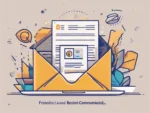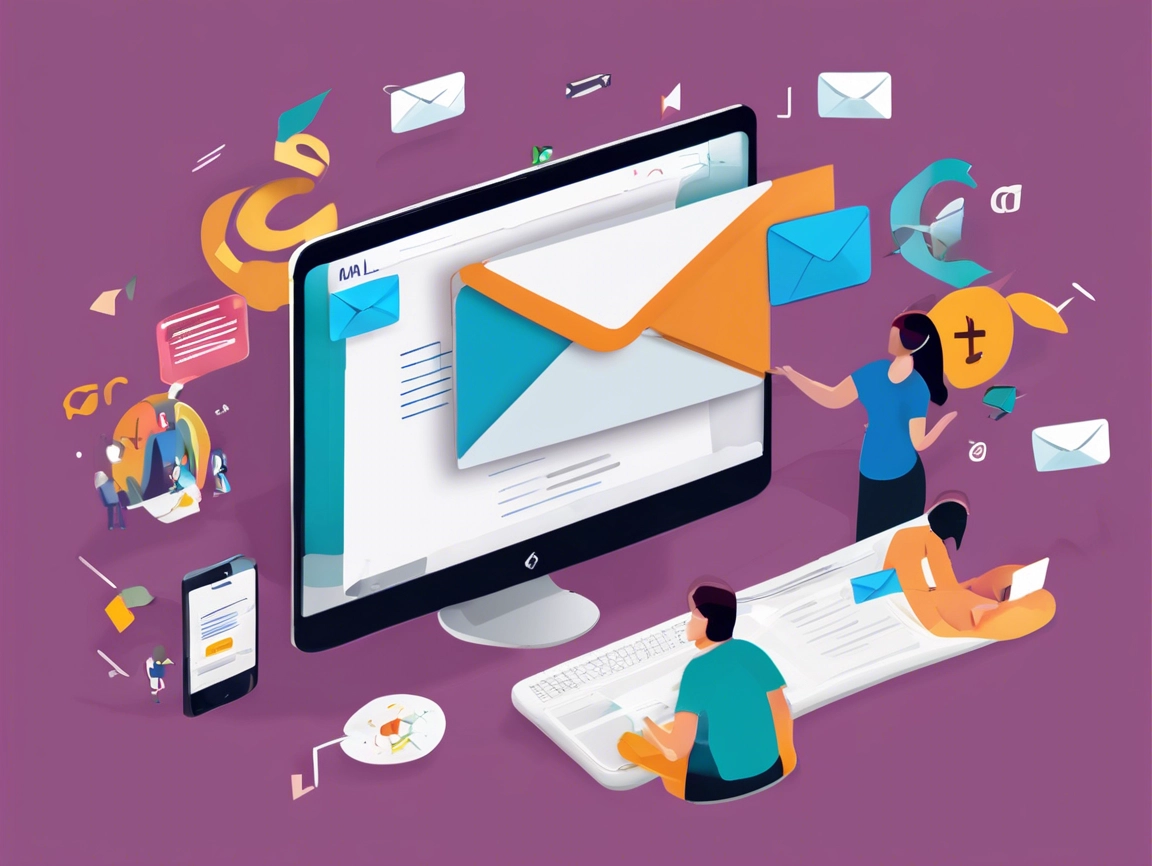
15 Powerful Benefits of Email Marketing That Make It a No-Brainer in 2025
Email marketing might not be the trendiest tool in digital marketing—but that’s exactly why it works. While the hype cycles push you toward the latest social platform or shiny content format, the smart long-term play is investing in assets you actually own. And aside from your website, your email list is the most valuable digital asset you can build.
Email gives you direct access to your audience, on your terms. It’s dependable, measurable, and one of the few marketing channels that consistently drives ROI. And yet, many marketers overlook it in favor of chasing algorithms and short-term attention.
In this post, I’ll walk you through the key benefits of email marketing—and why it deserves a central spot in your digital strategy.
Want a quick look at all the benefits? Here’s a visual summary of the 15 most powerful advantages of email marketing:
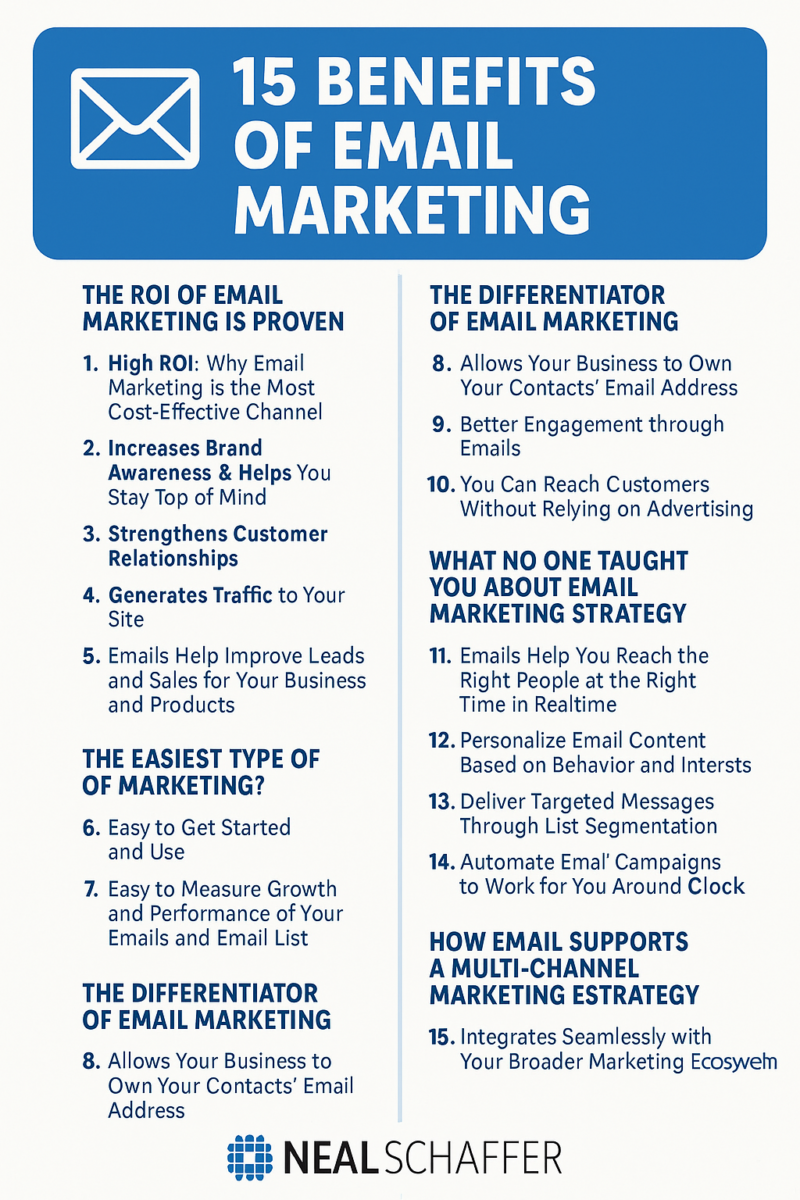
Why Email Marketing Offers Unmatched ROI
First, there’s one major reason why email marketing is used so much: it has an excellent ROI. Sometimes, this value is realized through specific sales that wouldn’t have happened without those emails.
However, many other benefits of email marketing are less obvious. Let’s dig into these other benefits related to increasing ROI one by one.
1. High ROI: Why Email Marketing Is the Most Cost-Effective Channel
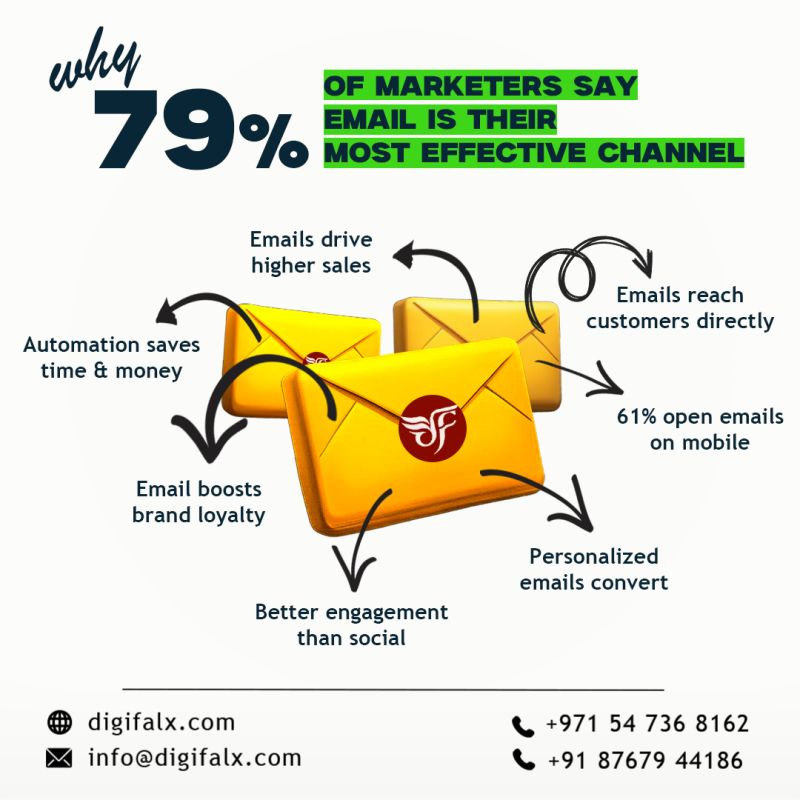
Email marketing consistently delivers the highest return on investment across digital channels. According to Litmus, brands earn an average of $36 for every $1 spent, making it one of the most cost-effective tactics in any marketer’s toolbox. Note that previously Litmus had said this number was as high as $42, but even 36X is an impressive number!
But industry averages only tell part of the story. Real-world email marketing campaigns show how companies can far exceed this benchmark with the right email marketing strategy:
- A SaaS company working with UnboundB2B achieved a 227% ROI increase in 12 weeks by using personalized email content and predictive analytics.
- Hinge Marketing, a professional services firm, reported over 420% ROI through consistent thought-leadership emails and segmented nurture sequences.
- A healthcare retailer implemented a 360° email strategy—including cart abandonment and welcome series—and saw a 400% increase in ROI, with 95% open rates and 81% CTR.
While tools and platforms come with some costs—from simple business email accounts to full-service automation—email remains remarkably affordable. Most of your expenses go toward writing effective messages and growing your list.
Still, email outperforms other digital channels. According to eMarketer, email’s ROI exceeds both social media marketing and paid search. That’s why it’s not just a cost-effective channel—it’s one of the most profitable.
Want even better results? Check out some of these recommended email marketing tools.
Further Reading: How to Measure Your Own Email Marketing ROI
2. Increase Brand Awareness and Stay Top of Mind
Whether your brand is just starting out, or has been around for over a century, one of the best benefits of email marketing is brand awareness. Often, consumers are looking for the next great thing, and if you’re a legacy brand then this issue can work against you. I mean, who buys the same cotton T-shirts from the value store anymore, right? Wrong! Plenty of people see the value of an old, reliable brand.
At the same time, being a new entrant into the market forces you to increase brand awareness so people will try your products. For brands of any age and size, though, staying at the top of consumer’s minds is a major advantage. Email marketing is one of the best ways to get there.
3. Build Stronger Customer Relationships with Email
Let’s look at this one from a human perspective. Most of us have the best relationships with people we talk to often—whether that’s through email, social media, or old-school methods. Email gives you the ability to keep that conversation going in a meaningful, scalable way.
Among the benefits of email marketing is the ability to strengthen customer relationships through consistent, helpful, and personalized communication. You can check in, share something valuable, offer support, or simply remind email subscribers that you’re still here and ready to help.
Because when all is said and done, brands are run by people—and it’s people who buy from brands they trust and feel connected to. Email gives you a direct line to nurture that trust over time at a deeper level.
Further Reading: How to Build Relationships through Email Marketing
4. Drive More Traffic to Your Website with Email Marketing
Simply put, if you include a link to your website in an email, there’s a good chance your subscribers will click. Whether you’re promoting your latest blog post, announcing a new product, or inviting them to read a press release, email gives you a direct way to drive qualified traffic right back to your site.
Even if a reader isn’t ready to buy, curiosity often leads them to explore—especially when the content feels relevant or timely. Once they land on your site, you have a chance to guide them deeper into your funnel through additional valuable content, special offers, or lead magnets.
Is Your LinkedIn Working?
Just released: my new book to help professionals, entrepreneurs, and business owners maximize LinkedIn for real growth.
With years of LinkedIn expertise, Maximizing LinkedIn for Business Growth offers actionable steps to build your brand, expand your network, and drive results.
Start leveraging LinkedIn like never before—grab your copy now! Click the cover or button below to buy on Amazon.
Just like with brick-and-mortar retail, getting someone through the “door” is half the battle. Email helps you do that consistently by keeping your audience engaged and giving them a reason to click through.
5. Use Email Marketing to Generate More Leads and Sales
There’s more to email marketing as a conversion tool than just getting clicks. It helps move people through your funnel—from awareness to decision—by delivering the right message at the right time.
In fact, 80% of professionals say that email marketing is one of the most effective ways to acquire and retain customers. And according to the Direct Marketing Association, 66% of consumers have made a purchase as a direct result of a marketing email.
That’s because email has the unique ability to nurture leads with value-based and relevant content, product education, and timely promotional campaigns—without feeling pushy. Done right, it builds trust while guiding people toward action. If you’re not using email to support your sales process, you’re leaving serious revenue on the table.
Email Marketing Is Simple, Scalable, and Measurable
One of the benefits of email marketing is that it’s easy to use. Almost everyone in the United States uses email to some extent, and so it’s a familiar medium. So long as you can avoid becoming an annoying spammer, your emails can become a great way to connect with consumers.
6. Email Marketing Is Easy to Start and Scales as You Grow
As I mentioned above, email marketing at scale does require some extra tools. However, most email platforms today are designed to be user-friendly, especially for beginners.
Getting started can be as simple as choosing a template, dragging in a few content blocks, and hitting “send.” Many platforms offer pre-built designs, free image libraries, and guided onboarding to help you launch your first campaign quickly—even if you’re not technical.
And the best part? It scales. As your business grows, you can build more sophisticated automations, segment your audience, and send highly targeted emails—all without having to rebuild your entire system. Start simple, and evolve as you go.
7. Track and Measure Email Marketing Performance with Ease
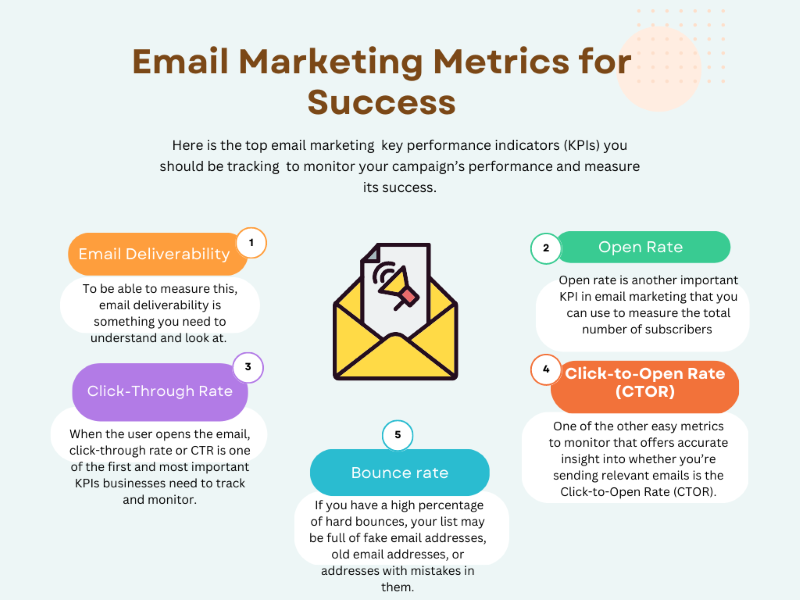
Email marketing gives you full visibility into how your campaigns are performing—and it’s one of the few communication channels where the data is both immediate and actionable.
At a basic level, most platforms show you:
- Open rate: how many people saw your subject line and opened the email
- Click-through rate (CTR): how many clicked a link in the email
- Bounce rate: how many emails didn’t reach inboxes
- Unsubscribe rate: how many people opted out of future emails
But to really understand how your email marketing is contributing to your business goals, go deeper:
- Click-to-open rate (CTOR) shows engagement after the open
- Conversion rate tells you how many people took a desired action—like buying a product or booking a call
- Revenue per email helps measure ROI campaign by campaign
- List growth rate gives you a clear picture of how healthy your audience-building efforts are
Many email platforms (like ConvertKit, Mailchimp, and ActiveCampaign) offer built-in dashboards for this. You can also connect your email tool to Google Analytics or your CRM to track things like email-driven purchases, signups, or sales opportunities.
The key takeaway? Email is one of the few digital marketing tactics where you can see not just who’s engaging—but how it’s impacting your bottom line.
Further Reading: Essential Email Marketing KPIs: 15 Metrics for Success
What Makes Email Marketing Stand Out from the Rest
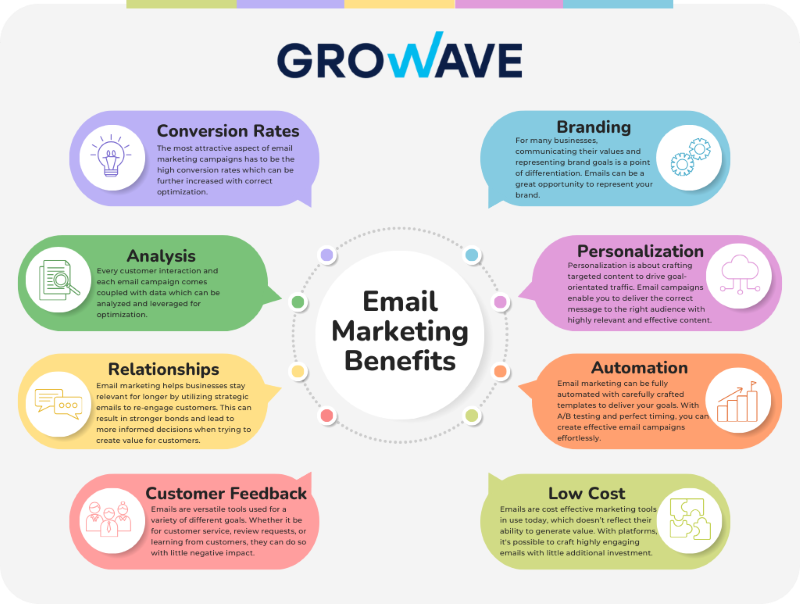
Have you ever thought about the fact that third parties have some degree of editorial control over most forms of advertising? Look at the Facebook rules, for instance, and you’ll see a host of disallowed speech. At the same time, magazines, TV, and radio all reject ads that don’t conform to their standards. Email is different, though. With email, there are very few restrictions and the definition of acceptable content is mostly defined by you and the consumer.
8. You Own Your Audience with Email Marketing
Among the benefits of email marketing is that email addresses are essentially private information. Due to the anti-spam regulations in most countries, you need permission to use people’s email for marketing purposes. This gives your brand a certain exclusivity: one way or another, people develop some affinity with your brand before emails can begin. Likewise, your competitors also need permission to email them. If a customer is brand loyal, then you have a huge advantage. Everyone else? They need another way to get attention.
9. Get Higher Engagement Rates Compared to Other Channels
For most of us, getting an email deserves a response. This is especially true when the sender is a person or company with which we have a connection. On the other hand, paid social, banner ads, and other traditional advertising is often ignored. Although most personal emails require a reply email, marketing emails don’t require the same level of engagement. Even clicking through and browsing the website can get results.
The difference between engagements from emails vs. social media is like night and day:
Naturally, there will always be emails that don’t need a response. For instance, an order confirmation email, while it provides an opportunity to sell something, is mostly informational. Then again, include a coupon to help reap the benefits of email marketing. Maybe your customer forgot something the first time.
10. Reach Your Audience Without Paying for Ads
Generally speaking, advertising is only seen when a customer navigates somewhere on the internet, pops open the newspaper or consumes other media. However, emails are a more intimate part of their lives. As robocalls ruin the act of answering the phone, email is becoming the best way for people to communicate. This is even more true for companies that need to contact people. Not only is email less intrusive, but everyone hates getting interrupted during dinner.
Here’s my point: the benefits of email marketing include an ability to reach customers anytime, anywhere. Smartphones mean that email is always at their fingertips, just like the radio used to be. And, you don’t have to pay Gmail for access to our customer. Just push the send button.
Strategic Email Marketing Tactics Most Brands Miss
Of course, reaping the benefits of email marketing requires proper strategy. After all, there’s more to email marketing than just cranking out words and phrases. Instead, everything needs to be done with specific and measurable goals in mind, and at the optimal time.
11. Reach the Right People at the Right Time with Real-Time Email
Just because email isn’t the new telephone ringing at dinner time doesn’t mean it isn’t time sensitive. What do I mean? Depending on your audience and their location, there are optimal times for sending marketing emails. For instance, B2B brands will want to target working hours, while B2C brands are likely to go for leisure time. The linkage between time and intended audience can be more complicated, however. Products such as hearing aids could be better marketed during the day, due to the high number of senior consumers.
Likewise, sending an email at the right time can spell the difference between the email getting buried by others, and its being opened. Fortunately, if you have an email program then the email can be pre-scheduled. This would allow a sender in California to reach a recipient in India at breakfast time, even if they work the day shift.
12. Personalize Email Content Based on User Behavior and Interests
Personalization in email marketing has come a long way from just adding someone’s name to the subject line. Today, smart email marketers use data like past behavior, interests, and buying stage to tailor messages that truly resonate.
With modern tools, you can segment subscribers based on their actions—like clicking a specific link, downloading a lead magnet, or abandoning a cart—and then deliver highly relevant messages that speak directly to their needs. This kind of personalized content leads to significantly better engagement and conversions.
You can also use dynamic content blocks to automatically display different sections of an email depending on who’s opening it. Imagine showcasing enterprise pricing for large business leads and basic plans for solopreneurs—all in a single campaign.
According to Campaign Monitor, emails with personalized subject lines generate 26% higher open rates, while segmented and personalized campaigns drive 760% more revenue than generic ones.
Whether you’re using tools like ActiveCampaign, ConvertKit, or Klaviyo, personalization features are built in—and easier than ever to implement. And the payoff is clear: more opens, more clicks, and more conversions.
13. Send Targeted Emails Using Smart List Segmentation
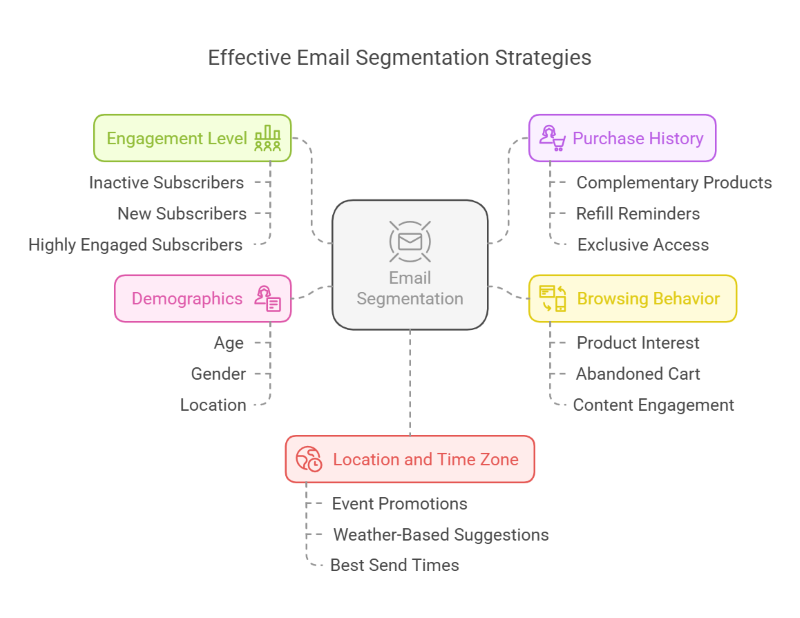
One of the most powerful aspects of email marketing is the ability to divide your audience into smaller, more focused groups. This process, called segmentation, allows you to send highly targeted messages that are more likely to resonate, convert, and build trust over time.
Instead of sending a one-size-fits-all email to your entire list, you can create segments based on factors like demographics, purchase history, website behavior, engagement, or where the subscriber is in the customer journey. For example, you might have one segment for first-time buyers, another for loyal customers, and a separate one for inactive subscribers.
This kind of targeting leads to better results. According to Mailchimp, segmented campaigns get 14.3% higher open rates and over 100% more clicks than non-segmented ones. And it’s not just about performance—segmented messaging can reduce unsubscribes and boost overall subscriber satisfaction.
Modern email marketing tools make this easy. Platforms like Mailchimp, ConvertKit, and Klaviyo offer drag-and-drop segmentation features that let you group your audience with just a few clicks. More advanced platforms allow for dynamic segments that update automatically based on user behavior or real-time data.
Effective segmentation ensures your messages are always relevant to the people receiving them, which is ultimately what drives long-term engagement and customer loyalty.
14. Automate Email Campaigns to Work for You Around the Clock
Email marketing doesn’t just save you time—it works while you sleep. With automation, you can set up campaigns that send the right message to the right person at exactly the right moment, without lifting a finger once it’s live.
Think of it like putting parts of your marketing on autopilot. Whether it’s a welcome series for new subscribers, a lead nurturing sequence triggered by a content download, or a cart abandonment reminder to recover lost sales—automation helps move people through your funnel in a personalized, efficient way.
The best part? It scales. You can automate one sequence or an entire customer journey, from awareness to conversion. Email marketing software like ConvertKit, ActiveCampaign, Mailchimp, and HubSpot make this easy to set up, even if you’re not technical.
Once you have automations in place, they continue delivering value long after you’ve hit publish—saving time, increasing engagement, and growing your business 24/7.
Further Reading: What is Email Marketing Automation and How Much Can You Actually Automate?
How Email Supports a Multi-Channel Marketing Strategy
As powerful as email marketing is on its own, its true potential shines when you use it alongside your other marketing efforts. Whether you’re active on social media, publishing relevant content, running webinars, or investing in paid ads, email can help tie everything together and keep your audience engaged across multiple touchpoints.
15. Integrates Seamlessly with Your Broader Marketing Ecosystem
One of the biggest strengths of email marketing that often gets overlooked is how seamlessly it fits into your overall digital strategy. Whether you’re running social media campaigns, paid ads, webinars, or publishing blog content, email connects the dots and reinforces your message across every touchpoint.
For example, someone who registers for a webinar or downloads a lead magnet can be automatically added to a targeted sequence—guiding them through your funnel without any manual follow-up. Some platforms even let you sync your email list with Facebook or Google Ads to run coordinated retargeting campaigns.
You can also use email to promote your latest blog posts, YouTube videos, podcast episodes, or even behind-the-scenes social content. It’s not just a support tool—it’s a central hub that amplifies and extends the reach of everything else you’re already doing.
That’s why I always recommend marketers look at email not just as a channel, but as the strategic core of a fully integrated marketing ecosystem.
Don’t Overlook the Power of Email Marketing
Email marketing isn’t just alive and well—it’s one of the most effective and versatile tools in your marketing toolbox. Whether you’re looking to build deeper customer relationships, drive traffic, increase conversions, or support your broader marketing efforts, email gives you the control and scalability to make it happen while improving the customer experience.
If you’re not taking full advantage of email marketing yet, now’s the time to start. And if you are, it’s worth asking: are you doing everything you could be to unlock its full potential?

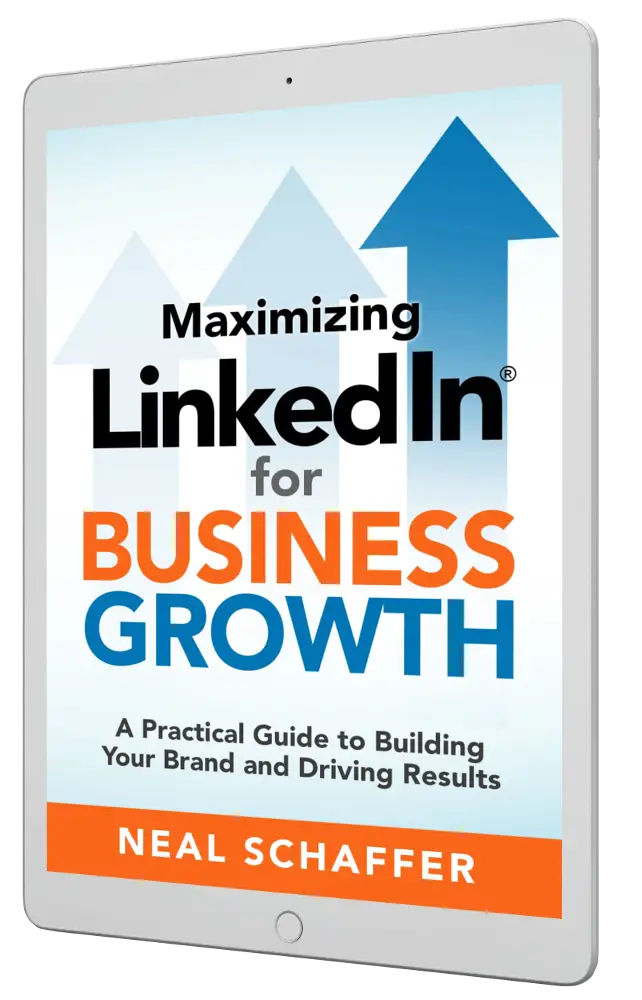
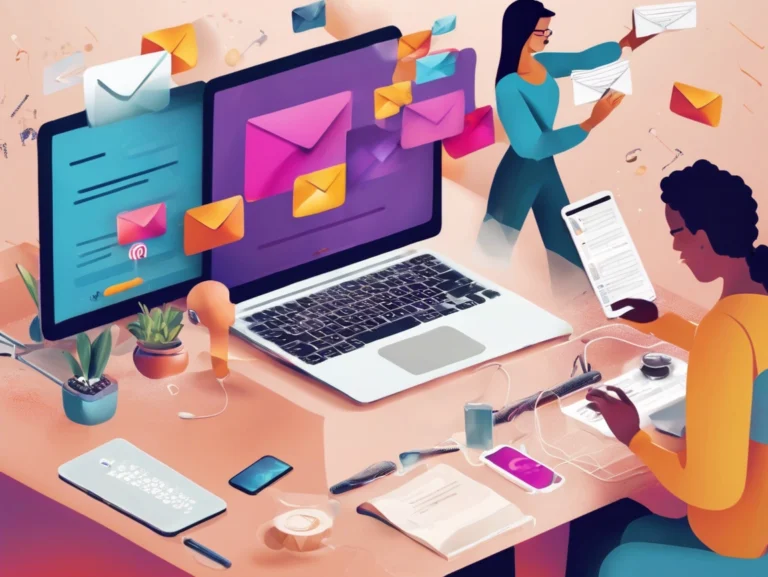

![How to Create Your Own Powerful Email Marketing Funnel [Step-by-Step]](https://nealschaffer.com/wp-content/uploads/5786fd41-08c3-411a-94d0-eea2c1062a74-768x577.webp)

